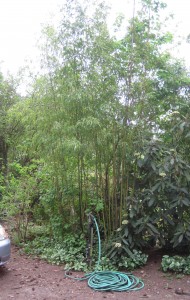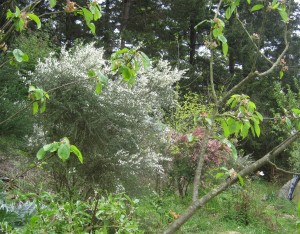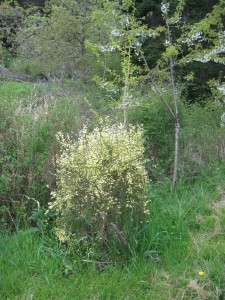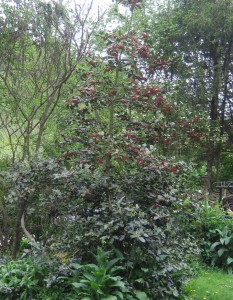Several years ago I posted a four-part discussion about permaculture and my concerns with the blend of philosophy, science and pseudoscience that it contains. (Here are links to Parts 1, 2, 3 and 4.) So I was pleased to be part of an Extension tour group that visited an established permaculture farm in the San Juan Islands earlier this spring. This gave me an opportunity to see whether there was any perceptible shift in the permaculture community towards practices based on applied plant and soil sciences. Specifically, I chose to look for invasive species identified as noxious weeds that many permaculturists cultivate rather than eradicate.

Our spring came early this year, and the islands were blindingly yellow with the Scots broom that runs rampant there (and throughout the West). This species is a Class B listed noxious weed in Washington State and has been mandated for control by San Juan County. So I was surprised and disappointed to see it and other related broom species not only present at this farm but used actively as nitrogen fixing species.

The practice here is to plant broom or some other nitrogen fixing species right next to a fruit tree as a “companion plant.” While the idea is logical, the choice of species is not. There are many other plants, including legumes and alders, which grow well in our area and would provide the same benefit.

There is nothing that can excuse the deliberate use of a listed noxious weed that’s mandated for control by local government. Permaculturists should endeavor to be good citizens and not infringe on the rights of their neighbors who don’t share their philosophy.

WSDA noxious weed listings for species mentioned in this post:
Scots broom
French broom
Spanish broom
Yellow archangel
English holly
When the Bullocks arrived over 30 years ago, their 5 acres and the 5 adjacent acres they lease were nearly solid Himalayan blackberries, broom, and reed canary grass. They eradicated nearly all of it using non-toxic methods. A few scattered invasives do remain, but if you’d gone to their neighbors’ properties, you’d see broad expanses of the same invasives left to spread rather than being controlled as the Bullocks are doing. Aren’t those the bad neighbors here? The brothers are also working with sterile varieties of broom and Genista hybrids. They are using alders, ceanothus, and other non-invasive N-fixers in addition to brooms, as you suggest. Plus, they restored a wetland that had been illegally drained by the previous owner, which returned otters, raptors, waterbirds, and other native species not seen for decades to the area. They planted natives extensively to replace the old farm’s exotics, controlled erosion, created huge plantings for native pollinators, and converted a once-monocultured farm containing little but exotic species to one of Orcas Island’s major centers of biodiversity and habitat, education, and a prime tourist attraction. An interesting choice to ignore all that and focus on a wire-caged Scots broom plant.
There is much to admire in the physical improvements the Bullocks have made to their site, as you have noted. For this particular blog posting, I was focusing specifically on invasive species. There were many, many more brooms on the property than the one companion planting I photographed. And what about the other listed noxious weeds that were allowed to flourish? I was not the only Extension specialist to raise their eyebrows during our visit.
And sure, there are other people on the island with uncontrolled population of Scots broom. It makes it even more frustrating, therefore, that the Bullocks don’t manage the listed noxious weeds on their property. This hardly sets an educational example for the public, especially given their recognition as a “major center of biodiversity and habitat, education, and a prime tourist attraction.”
Hi,
I lived on this site for 7 years. I was very surprised to read what you’ve written here as it clearly demonstrates that you did not bother to ask questions while you were on the site (not exactly the mark of “good science”). You provide no context, just photos that demonstrate your predetermined message. Interestingly, that message (invasive species are bad) is only tenuously related to your title. I’m not actually sure your content even tries to prove your title statement.
Here is some further information that I feel you should have:
1) The Scot’s Brooms you have photographed (white flowered, red, light-yellow) are all sterile hybrids. They do not, as implied, set viable seed.
2) The bright yellow-flowered Scot’s Broom that you saw is being managed. Had you asked you would find out that we like to wait until it begins flowering, then we cut them with loppers and mulch with them. By waiting until they flower, they are easier to see and we’re less likely to miss one. We always do our best to catch them before they reached the stage of seed ripening. If a seed did ripen and grow, it happened in a cultivated area (remember we mulch with the tops), so we could easily eliminate it.
3) You imply that we are cultivating Yellow Archangel. Again, had you asked you would have learned that it came in on some brush brought home from a landscaping job and we don’t want it there any more than you do. I imagine you also know how difficult to eliminate it is. Regardless of what you think of our “science,” at the end of the day, we do not want to cultivate ANYTHING that is going to make more work for us. That doesn’t make sense. We have plenty of work to do (try to find a farmer who doesn’t).
4) The French Brooms (Genista spp.) have NEVER in 30 years spread a single viable seed.
5) We had a single specimen of Spanish Broom on the property for 20+ years. We wanted to propagate it for its amazing fragrance and capacity to build soil, but it never set seed so we could not. It would seem that our particular location does not provide the conditions for Spanish Broom to spread. Should that change we would likely switch to a different species. Again, we aren’t trying to set ourselves up for an extra 4 hour shift of weed management each week, so we’re not trying to spread noxious weeds.
The field of systems thinking teaches us that lack of good information for all parties leads to system malfunction (especially true of social systems). If people are only presented with a small portion of the information pertinent to an issue, they often have inadequate information from which to draw a correct conclusion. By omitting the information I have included here, you have presented a problem, identified an enemy, and helped people to conclude that they are wrongdoers. I hope that this easily available information can help to muddy those waters so people do not, as you have intended, believe that all permaculturists are anti-science, spreaders of noxious weeds, and plagues to their neighbors.
First, I (and many others in the tour) did ask questions. However, it was not my intention to monopolize the discussion and I did not have the opportunity to ask as many questions as I would have liked. Nor did the WSU weed specialist who was also on the tour and shared my alarm at the WSDA-listed noxious weeds including butterfly bush and holly as well as the brooms and yellow archangel. I was told by our hosts that the broom was being managed, but there was no evidence of any pruning. I don’t know if seed was forming on those plants that I saw at the farm but I know that elsewhere in the islands it was.
Second, I’m not going to argue with you about the probability that your other broom species will become invasive. There is a well-known decision tree that helps one predict what plants are most likely to become invasive (Reichard, S.H. and Hamilton, C.W., 1997. Predicting invasions of woody plants introduced into North America. Cons. Biol. 11: 193-203). All brooms are highly likely to become invasive based on their life history characteristics and French and Spanish broom are both invasive in Washington, Oregon and California. Understanding how species become invasive involves understanding that it can take decades for an introduced population to become adapted to local conditions and begin reproducing. You might be interested in UC Davis’ guide to broom management, which pretty much says the same thing. http://www.ipm.ucdavis.edu/PMG/PESTNOTES/pn74147.html.
Third, there is no evidence that sterile hybrids will stay that way. “‘Sterile’ varieties of these plants haven’t been independently verified or tested and are not recommended as substitutes” (http://www.cal-ipc.org/landscaping/dpp/pdf/SoCalPrintable.pdf).
All of this information is readily available not only from the Internet but from your state Extension specialists, including myself and university weed specialists. Dr. Sarah Reichard at the University of Washington (who developed the decision key I mentioned) is also a resource to you as an international expert on invasion biology. Have you ever contacted any of these experts to discuss invasive plant issues at the farm? If not, I’m curious as to where you obtain the science on the topic.
I went and read all your posts on permaculture and quite enjoyed them. I love permaculture–but like anything in the gardening world it is filled with misinformation. I went into it with a horticulture degree and was grateful to that because it helped me ignore and disagree with some of the recommendations and misinformation there. Permaculture is more philosophical than scientific in nature, but is not useless, it simply needs to be used not in place of sound science, but in connection with it.
There are some weeds that pop up just because they are weeds…noxious weeds are noxious usually because they spread like mad. I wouldn’t even want to use them because they are often difficult to eradicate (and many support species in permaculture are slated for eventual removal).
I agree 100% Liz. I would love to see the permaculture world work with one or more scientists to come up with credible book on science-based permaculture practice.
Linda, as you recall, I was standing at your side when we walked through the small orchard where Scots broom was being cultivated as a companion plant to a fruit tree. While I acknowledge that it is a listed species, bureaucratic decree does not eliminate any potential benefit that a plant, invasive or otherwise may serve. In the case of the Bullock brothers’ farm, they were cultivating a handful of listed invasives. but, they were doing so intentionally, and for valid reasons (regardless of the legality – which should have little bearing on the ecological context). The thing that amazed me most–after driving around the islands, spotted butter yellow with broom–was that aside from the cultivated/caged broom and a few specimens in other locations, there were no volunteers anywhere that stood out to me. If nothing else, this should speak to the diligence of the caretakers, as well as the ecological knowledge required to prevent such invasives from becoming, well, invasive.
Broom doesn’t tend to be as much of a problem in Eastern Washington as it is on the west side. I grew up on a small farm in south Tacoma manually pulling up broom volunteers from the unmanaged pasture next to us. It was of economic necessity, because the broom outcompetes most of the grass needed for the free-range Hereford cattle we raised. That’s an ecological reality as well as an economic one. In my opinion, there is no valid excuse for deliberately growing listed noxious weeds – which get on to Washington’s noxious weed list precisely because they cause economic problems. The west side of the state supports an abundant number of species, including natives and noninvasive introduced species that fix nitrogen. There really no good reason for growing and actively promoting the use of Scots broom. (Or any of the other invasives on site.)
Rationalizing the use of Scots Broom to enhance growth of nitrogen-needy trees is analogous to justifying the employment a psychopathic teen armed with an AK47 to guard your house. “When they’re good, they’re very, very good; when they’re bad, they are horrid.”